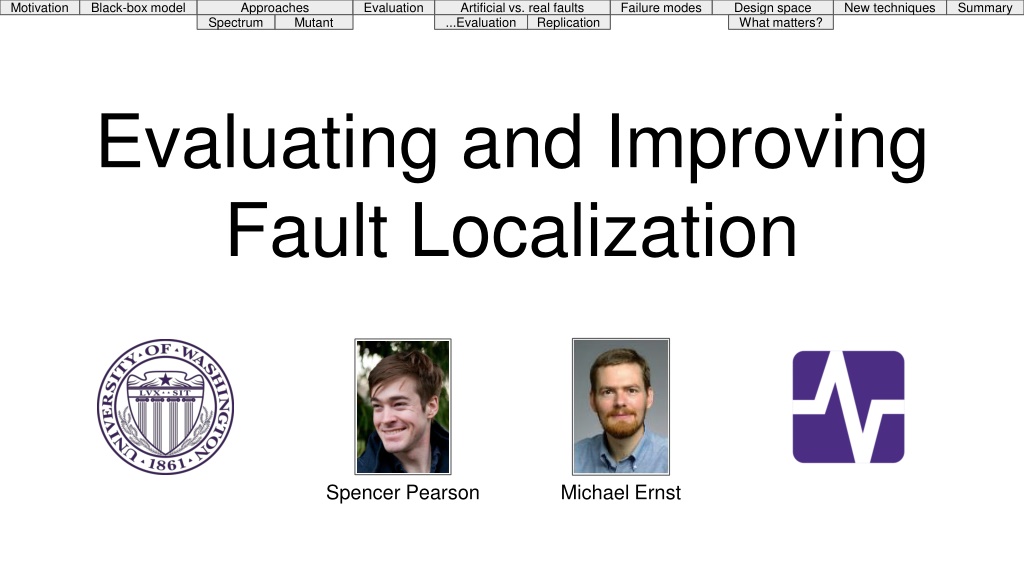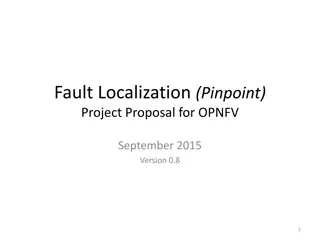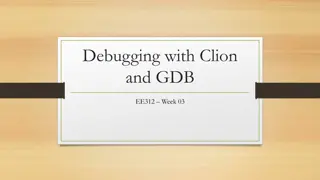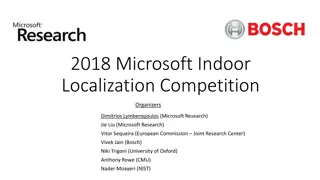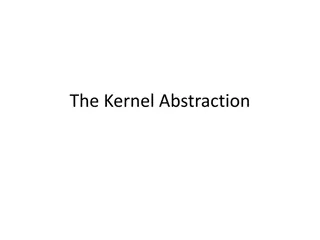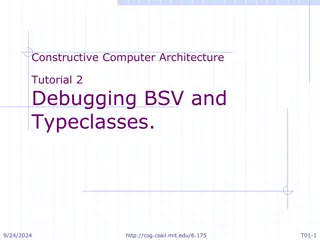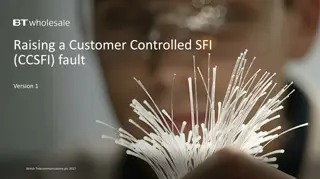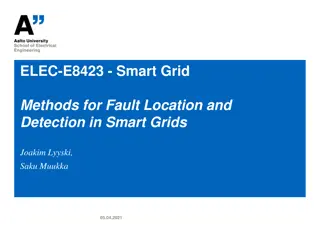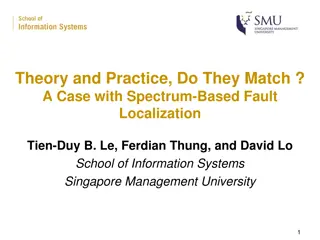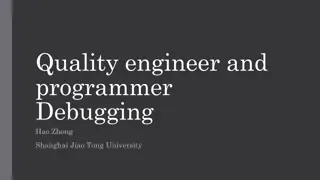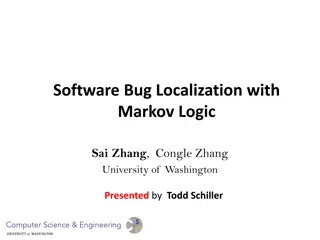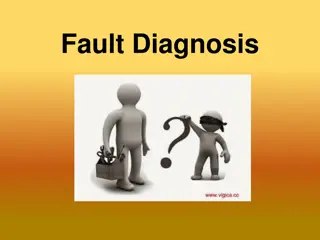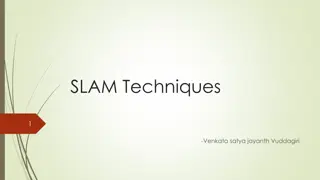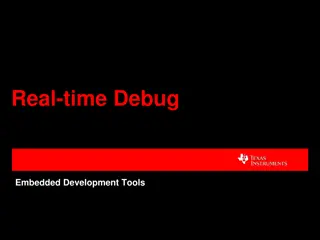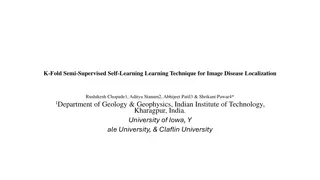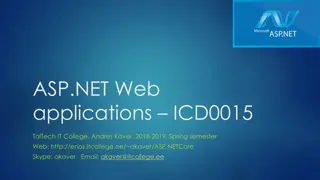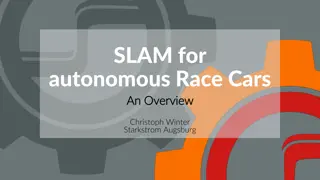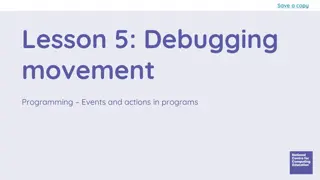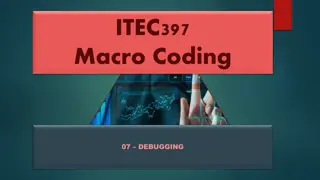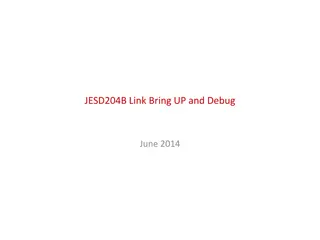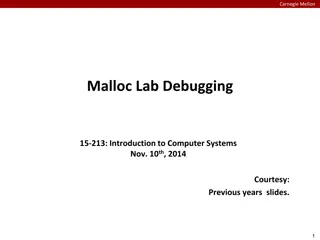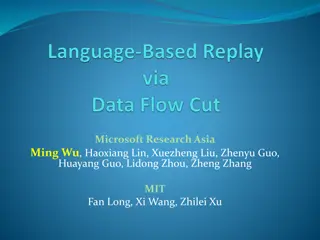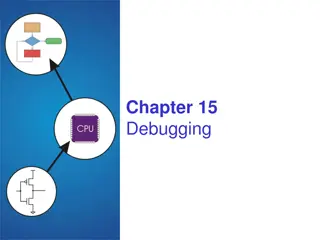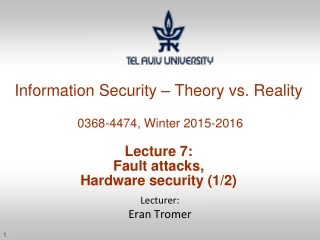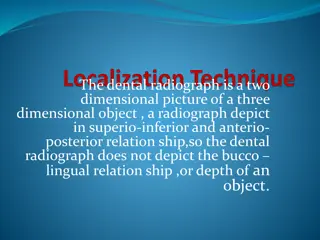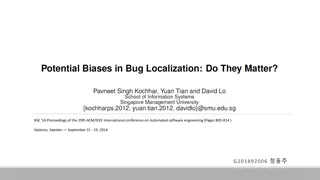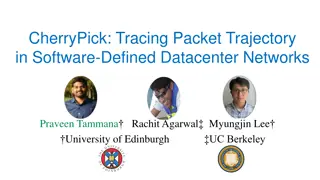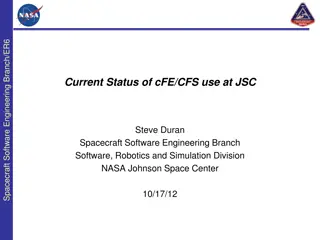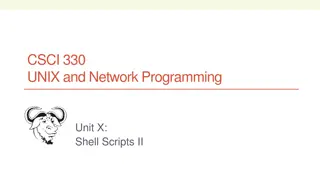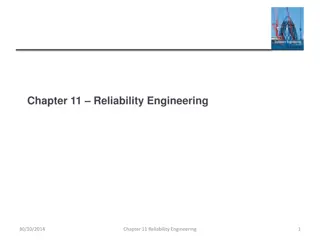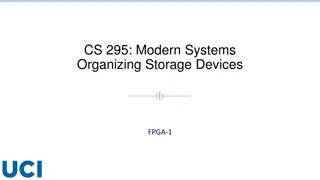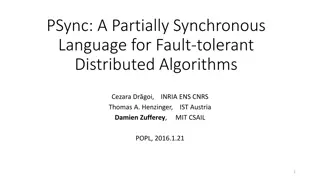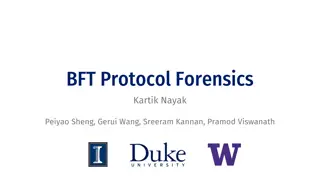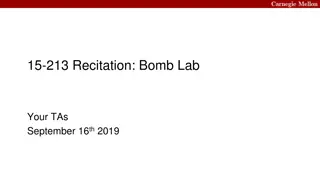Exploring Fault Localization Techniques in Software Debugging
Various fault localization techniques in software debugging are discussed, including black-box models, spectrum evaluation, comparison of artificial and real faults, failure modes, and design considerations. The importance of effective fault localization and improving fault localization tools is highlighted through analysis of approaches like mutant replication and evaluation of fault localization methods.
Download Presentation

Please find below an Image/Link to download the presentation.
The content on the website is provided AS IS for your information and personal use only. It may not be sold, licensed, or shared on other websites without obtaining consent from the author. Download presentation by click this link. If you encounter any issues during the download, it is possible that the publisher has removed the file from their server.
E N D
Presentation Transcript
Motivation Black-box model Approaches Spectrum Evaluation Artificial vs. real faults ...Evaluation Failure modes Design space What matters? New techniques Summary Mutant Replication Evaluating and Improving Fault Localization Spencer Pearson Michael Ernst
Motivation Black-box model Approaches Spectrum Evaluation Artificial vs. real faults ...Evaluation Failure modes Design space What matters? New techniques Summary Mutant Replication Debugging is expensive Your program has a bug. What do you do? Reproduce it Locate it Fix it Focus of this talk
Motivation Black-box model Approaches Spectrum Evaluation Artificial vs. real faults ...Evaluation Failure modes Design space What matters? New techniques Summary Mutant Replication Fault localization as a black box Passing tests (3) c = foo; Line ranking (1) u = bar(); (4) while (c < u) (2) Failing tests Fault localization tool c = c.baz(); Program (5) return c; c = foo; u = bar(); while (c < u) c = c.baz(); return c;
Motivation Black-box model Approaches Spectrum Evaluation Artificial vs. real faults ...Evaluation Failure modes Design space What matters? New techniques Summary Mutant Replication Agenda Spectrum-based and mutant-based fault localization Evaluating fault localization techniques Fault provenance: are artificial faults good proxies for real faults? No! Why not? What matters on real faults, then? Doing better
Motivation Black-box model Approaches Spectrum Evaluation Artificial vs. real faults ...Evaluation Failure modes Design space What matters? New techniques Summary Mutant Replication Let s design a FL technique! if (unflushedValues > 0) { if (index >= 0 && !this.allowDuplicateXValues) { XYDataItem existing = (XYDataItem) this.data.get(index); try { overwritten = (XYDataItem) existing.clone(); } catch (CloneNotSupportedException e) { throw new SeriesException("Couldn't clone XYDataItem!"); } existing.setY(y); } ... More Os more suspicious More Os less suspicious
Motivation Black-box model Approaches Spectrum Evaluation Artificial vs. real faults ...Evaluation Failure modes Design space What matters? New techniques Summary Mutant Replication Let s design a FL technique! For each statement Line# Susp. Line# # - 1 0.2 7 sort 2 0.5 6 # - 3 0.0 2 ... ... ... weighting factors
Motivation Black-box model Approaches Spectrum Evaluation Artificial vs. real faults ...Evaluation Failure modes Design space What matters? New techniques Summary Mutant Replication There are many variants on spectrum-based FL: Ochiai[1] Tarantula[2] D*[3] [1] R. Abreu, P. Zoeteweij, and A. J. C. van Gemund. An evaluation of similarity coefficients for software fault localization. [2] J. Jones, M. J. Harrold, and J. Stasko. Visualization of test information to assist fault localization. [3] W. E. Wong, V. Debroy, R. Gao, and Y. Li. The DStar method for effective software fault localization.
Motivation Black-box model Approaches Spectrum Evaluation Artificial vs. real faults ...Evaluation Failure modes Design space What matters? New techniques Summary Mutant Replication Another approach to FL: mutation-based def f(arg): if arg not in cache: return cache[arg] ... cache[arg] = (start+stop)/2 cache.sync() return (start+stop+1)/2 return (start+stop+1)/2 def f(arg): if arg in cache: return cache[arg] ... cache[arg] = (start+stop)/2 cache.sync() def f(arg): if arg in cache: return cache[arg] ... cache[arg] = (start-stop)/2 cache.sync() return (start+stop+1)/2 def f(arg): if arg in cache: return cache[arg] ... cache[arg] = (start+stop)/2 cache.sync() return (start+stop+0)/2 def f(arg): if None in cache: return cache[arg] ... cache[arg] = (start+stop)/2 cache.sync() return (start+stop+1)/2 def f(arg): if arg in cache: return cache[arg] ... cache[arg] = (start+stop)*2 cache.sync() return (start+stop+1)/2 def f(arg): if arg in cache: return cache[arg] ... cache[arg] = (start+stop)/2 cache.sync() return (start/stop+1)/2 More more suspicious More less suspicious def f(arg): if arg in None: return cache[arg] ... def f(arg): if arg in cache: return cache[arg] ... def f(arg): if arg in cache: return cache[arg] ...
Motivation Black-box model Approaches Spectrum Evaluation Artificial vs. real faults ...Evaluation Failure modes Design space What matters? New techniques Summary Mutant Replication Another approach to FL: mutation-based For each mutant Mut# Susp. Line# Susp. Line# # - 1 0.1 1 0.2 7 collect sort 2 0.6 2 0.5 6 # - 3 0.1 3 0.0 2 ... ... ... ... ... weighting factors
Motivation Black-box model Approaches Spectrum Evaluation Artificial vs. real faults ...Evaluation Failure modes Design space What matters? New techniques Summary Mutant Replication There are few variants on mutation-based FL: Metallaxis[1] MUSE [2] collect [1] M. Papadakis and Y. Le Traon. Metallaxis-FL: Mutation-based fault localization. [2] S. Moon, Y. Kim, M. Kim, and S. Yoo. Ask the mutants: Mutating faulty programs for fault localization.
Motivation Black-box model Approaches Spectrum Evaluation Artificial vs. real faults ...Evaluation Failure modes Design space What matters? New techniques Summary Mutant Replication How do you tell whether a FL technique is good? Program + Tests + Tests + Program + Program + Tests + Defect knowledge Defect knowledge Defect knowledge Program + Tests + Defect knowledge Defect Find defect in ranking Passing tests Score (smaller = better) (3) u = foo; Line ranking avg Failing tests 4/90 0.04 (1) c = bar(); 3/5 3/5 FL FL FL (4) while (c < u) 3/5 3/5 0.05 Program (2) c = c.baz(); ... 3/5 3/5 0.01 Blue technique is the best FL technique
Motivation Black-box model Approaches Spectrum Evaluation Artificial vs. real faults ...Evaluation Failure modes Design space What matters? New techniques Summary Mutant Replication How do you get defect information for evaluation? Artificial faults (mutants) + Easy to make lots of faults + Easy to reason about - Not necessarily realistic Program + Tests + Program + Tests + Defect knowledge Defect knowledge Program + Tests + Defect knowledge Used by previous research int x; int sum; int iters; sum = xs[0]; ... ... int x; int sum; Real faults (from issue trackers) - Hard to collect; fewer faults - Diverse and complicated + Reflect real-world use cases Provided by the recent project Defects4J [1] sum = xs[0]; [1] Just et al. "Defects4J: A database of existing faults to enable controlled testing studies for Java programs." ISSTA 2014 Proceedings. ACM, 2014.
Motivation Black-box model Approaches Spectrum Evaluation Artificial vs. real faults ...Evaluation Failure modes Design space What matters? New techniques Summary Mutant Replication Are artificial faults good substitutes for real faults? A FL technique that does well on artificial faults may do badly on real ones! We: generated many artificial faults by mutating fixed statements repeated previous comparisons on artificial faults on real faults SBFL-SBFL Do the same techniques win on both? No! MBFL-SBFL
Motivation Black-box model Approaches Spectrum Evaluation Artificial vs. real faults ...Evaluation Failure modes Design space What matters? New techniques Summary Mutant Replication Are artificial faults good substitutes for real faults? (No!) Artificial faults Real faults better
Motivation Black-box model Approaches Spectrum Evaluation Artificial vs. real faults ...Evaluation Failure modes Design space What matters? New techniques Summary Mutant Replication Why the difference? Real faults often involve unmutatable lines (e.g. break, return) MBFL does very well on reversible artificial faults sum = sum + x create fault mutate sum = sum - x sum = sum + x
Motivation Black-box model Approaches Spectrum Evaluation Artificial vs. real faults ...Evaluation Failure modes Design space What matters? New techniques Summary Mutant Replication Common structure For each mutant Line# Susp. Line# # - 1 0.2 7 sort 2 0.5 6 # - 3 0.0 2 ... ... ... weighting factors
Motivation Black-box model Approaches Spectrum Evaluation Artificial vs. real faults ...Evaluation Failure modes Design space What matters? New techniques Summary Mutant Replication Common structure For each mutant Mut# Susp. Line# Susp. Line# # - 1 0.1 1 0.2 7 collect sort 2 0.6 2 0.5 6 # - 3 0.1 3 0.0 2 ... ... ... ... ... weighting factors
Motivation Black-box model Approaches Spectrum Evaluation Artificial vs. real faults ...Evaluation Failure modes Design space What matters? New techniques Summary Mutant Replication Common structure For each element Elem# Susp. Line# Susp. Line# # - 1 ... 1 0.2 7 collect sort 2 ... 2 0.5 6 # - 3 ... 3 0.0 2 (identity for SBFL) ... ... ... ... ... weighting factors
Motivation Black-box model Approaches Spectrum Evaluation Artificial vs. real faults ...Evaluation Failure modes Design space What matters? New techniques Summary Mutant Replication Common structure # - Technique Space weighting factors collect # - Important SBFL MBFL: what counts as a failing test detecting a mutant? AnError(1) AnError(2) AnError OtherError AnError pass Unimportant
Motivation Black-box model Approaches Spectrum Evaluation Artificial vs. real faults ...Evaluation Failure modes Design space What matters? New techniques Summary Mutant Replication New techniques SBFL and MBFL both have outliers but in different cases! Average them together! Other (smaller) improvements: Make MBFL incorporate mutant coverage information Increase resolution of SBFL by using mutants
Motivation Black-box model Approaches Spectrum Evaluation Artificial vs. real faults ...Evaluation Failure modes Design space What matters? New techniques Summary Mutant Replication Summary if (unflushed if (index > XYDataIte try { overwri } catch (Cl throw n } existing. } ... def f(arg): if arg not in cache: return cache[arg] ... cache[arg] = (start+stop)/2 cache.sync() return (start+stop+1)/2
Motivation Black-box model Approaches Spectrum Evaluation Artificial vs. real faults ...Evaluation Failure modes Design space What matters? New techniques Summary Mutant Replication Future work Are artificial faults still bad proxies for real faults with other families of FL techniques? Could generated test suites make artificial faults Better proxies? Do some mutation operators produce better artificial faults than others?
Motivation Black-box model Approaches Spectrum Evaluation Artificial vs. real faults ...Evaluation Failure modes Design space What matters? New techniques Summary Mutant Replication
Motivation Black-box model Approaches Spectrum Evaluation Artificial vs. real faults ...Evaluation Failure modes Design space What matters? New techniques Summary Mutant Replication Alternative metric: top-n Average percent through the program until first faulty statement might not be the best metric. Alternative: probability a faulty statement is in the n most suspicious. n=5 for debugging, n=200 for program repair tools[1] [1] F. Long and M. Rinard. An analysis of the search spaces for generate and validate patch generation systems.
